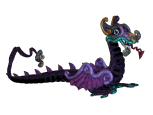
Main Entry: fa·er·ie
Variant(s): also fa·ery /'fA-(&-)rE, 'far-E, 'fer-E/
Function: noun
Inflected Form(s): plural fa·er·ies
Etymology: Middle French faerie -- more at FAIRY
Date: 1590
1 : FAIRYLAND
2 : FAIRY

- faery adjective
Main Entry: fairy
Pronunciation: 'far-E, 'fer-
Function: noun
Inflected Form(s): plural fair·ies
Etymology: Middle English fairie fairyland, fairy people, from Old French faerie, from feie, fee fairy,
from Latin Fata, goddess of fate, from fatum fate
Date: 14th century
A mythical being of folklore and romance usually having diminutive human form and magic powers.

Entry Word: fairy
Function: noun
Text: a benevolent mythical being <children who believe in fairies>
Synonyms brownie, elf, fay, nisse, pixie, sprite
Related Word gremlin, imp, leprechaun, puck; dwarf, gnome, goblin, kobold
Contrasted Words ogre, troll

fairy
also spelled FAERIE or FAERY a mythical being of folklore and romance usually having magic powers and dwelling on earth in close relationship with humans. It can appear as a dwarf creature typically having green clothes and hair, living underground or in stone heaps, and characteristically exercising magic powers to benevolent ends; as a diminutive sprite commonly in the shape of a delicate, beautiful, ageless winged woman dressed in diaphanous white clothing, inhabiting fairyland, but making usually well-intentioned intervention in personal human affairs; or as a tiny, mischievous, and protective creature generally associated with a household hearth.

While the term fairy goes back only to the Middle Ages in Europe, analogues to these beings in varying forms appear in both written and oral literature, from the Sanskrit gandharva (semidivine celestial musicians) to the nymphs of Greek mythology and Homer, the jinni of Arabic mythology, and similar folk characters of the Samoans, of the Arctic peoples, and of other indigenous Americans. The common modern depiction of fairies in children's stories represents a bowdlerization of what was once a serious and even sinister folkloric tradition. The fairies of the past were feared as dangerous and powerful beings who were sometimes friendly to humans but could also be cruel or mischievous.

Fairies are usually conceived as being characteristically beautiful or handsome and as having lives corresponding to those of human beings, though longer. They have no souls and at death simply perish. They often carry off children, leaving changeling substitutes, and they also carry off adults to fairyland, which resembles pre-Christian abodes of the dead. People transported to fairyland cannot return if they eat or drink there. Fairy and human lovers may marry, though only with restrictions whose violation ends the marriage and, often, the life of the human. Some female fairies are deadly to human lovers.

Fairies are said to be of human size or smaller, down to a height of 3 inches (7.5 cm) or less. Female fairies may tell fortunes, particularly prophesying at births and foretelling deaths. Several herbs, especially St.-John's-wort and yarrow, are potent against fairies, and hawthorn trees, foxglove, and groundsel are so dear to them that abuse of these plants may bring retribution.

Fairy
lore is particularly prevalent in Ireland, Cornwall, Wales, and
Scotland. Fairies are common in literature from the Middle Ages on and
appear in the writings of the Italians Matteo Boiardo and Ludovico Ariosto,
the English poet Edmund Spenser, the Frenchman Charles Perrault, and the
Dane Hans Christian Andersen, among others.
See also brownie; dwarf; elf; fairy tale; goblin; kobold; leprechaun;
Märchen;
pixie.
(definitions from Merriam-Webster Online) note: link opens in a new window
